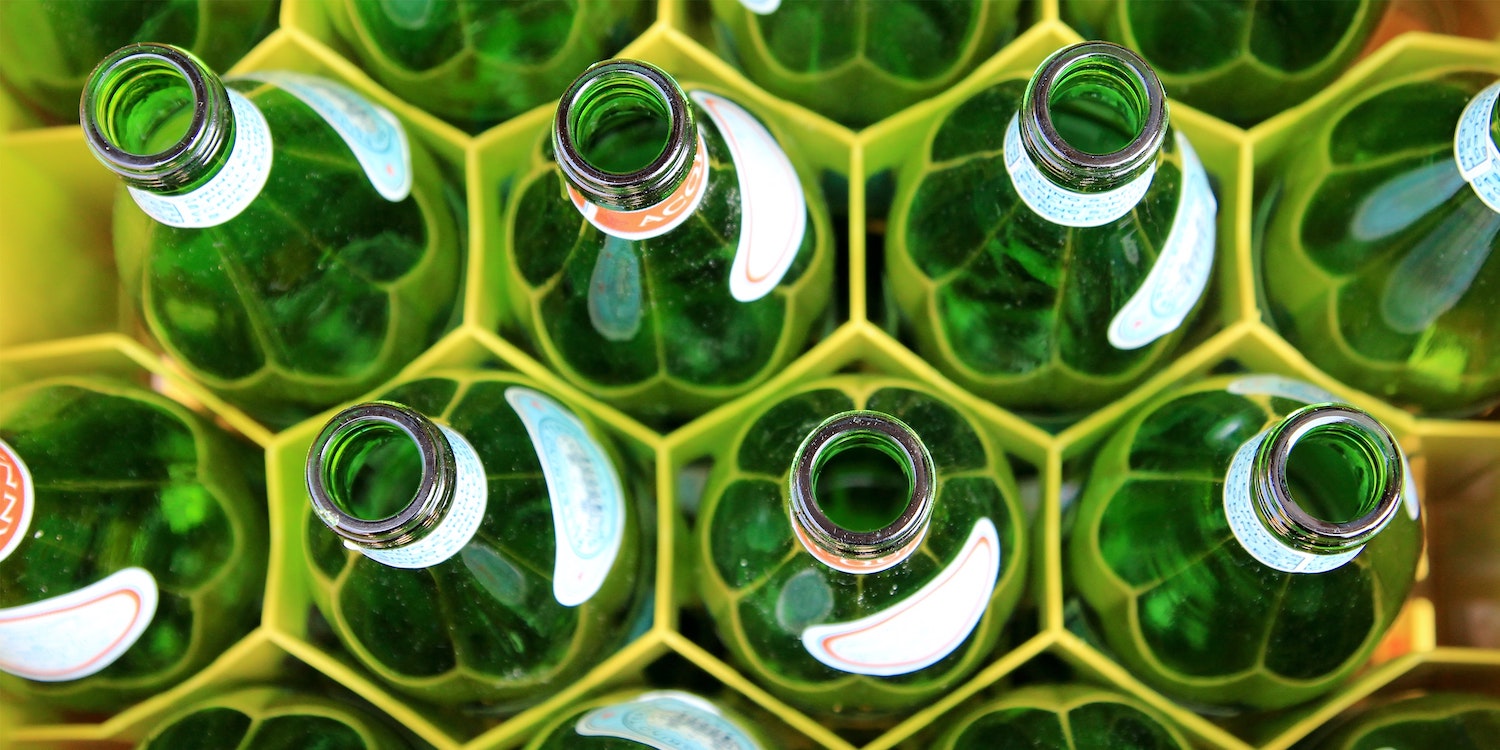Recycling is one of the biggest topics in the sustainability world. It's also one of the first steps people take when they want to live with less impact on our beautiful planet – and with good cause.
For one, it’s fairly easy to do, and once you’ve learned how to recycle, you’ve got your bases covered. Right?
Well… about that. There’s one thing we rarely discuss when it comes to recycling – the fact that some materials are easier and better to recycle than others.
After all, do you know how many times that plastic bottle actually gets recycled? And what happens to that notebook after you toss it in the bin – is it turned into a new notebook, or something else?
Excellent questions.
So today, we’re digging into infinitely recyclable materials, and why some materials triumph over others in the eyes of Mother Nature. So, are you ready to up your sustainability game?
Let’s get into it.
What does ‘Infinitely Recyclable’ Mean?
Infinitely recyclable is exactly what it sounds like – materials that can be recycled into infinity... without the quality of the material degrading.
While the phrase ‘recyclable’ is attached to countless products these days, that doesn’t mean they can all be recycled forever. In fact, most materials can only go through the process a handful of times.
See, the aim is to restore materials to their original form, so we can turn them into something new. But to do so, we must first break the materials down.
Recycled aluminum cans, for example, take 95% less energy to produce than cans made from new aluminum.
This is where things get complicated. See, most materials weaken during the process, and the quality of the material itself degrades. This loss of quality means the new product is weaker than the original one – and eventually, it’s too weak to be recycled again.
That's what we call downcycling.
But infinitely recyclable is also different from upcycling – that’s when an item is given a new purpose, without getting broken down at all.
The real difference here is in the properties of the material itself. Some materials can be recycled over and over again, and still come out just as high quality as they were to begin with.
But why does the difference matter? After all, recycling is recycling, right?
Benefits of Infinitely Recyclable Materials
Infinitely recyclable materials have many benefits. Two of the biggest ones are that they save us both energy and precious resources.
If we can reuse the materials we already have, it saves us from having to extract new raw materials to use. Since virtually all of our natural resources are slowly depleting, this is essential for a sustainable future.
Cutting down forests and extracting metals are also energy-heavy processes that can damage our ecosystems – throwing the planet further out of balance.
But not only do we save energy by not using new natural resources. The production itself is also more energy-efficient. While it does take some energy to recycle, it takes far less than making things out of raw materials. Recycled aluminum cans, for example, take 95% less energy to produce than cans made from new aluminum.
But, you might be thinking, that’s true for all recycled materials, not just infinitely recyclable ones. And you’re right – the biggest difference between those that can be recycled forever and those that can’t? Waste.
Because what happens when that piece of plastic can't be recycled again? Or when the paper has become too weak to make something new with?
You guessed it – landfill.
Infinitely recyclable materials offer us a chance to create a truly circular economy and production chain.
And not only are our landfills already overflowing with trash we’ll never be able to get rid of. Once something is too weak for recycling, we still have to extract new raw materials to replace them.
Now, it's crucial to recycle things as many times as we can. It saves both resources and energy, and ensures we’re wasting as little as possible.
But relying on materials that will eventually need to be replaced means we haven’t yet closed the circle. We still need to extract new raw materials, we’re still creating more trash – and we’re still hollowing out Earth’s limited resources.
Infinitely recyclable materials, on the other hand, offer us a chance to create a truly circular economy and production chain. This makes it the most sustainable solution we have, and key to a better future.
What Materials are Infinitely Recyclable?
So, which materials are infinitely recyclable? The short answer is metal and glass – they can both be melted down, remolded, and still come out as high-quality as ever.
But the long answer? Different recycling centers accept different things, and both metals and glass come in many shapes and forms. And what about other materials – how many times can you recycle different items?
To help you out, we’ve created a quick and easy guide to the most common materials and how they’re recycled:
Metals:

Virtually all metals are infinitely recyclable. Melting down iron, steel, and copper has been done since ancient times, and it’s one of the earliest traces of recycling in history. Metals are durable and can be used for a range of different products – but they’re also very easy to recycle, which makes them incredibly sustainable.
For example, did you know that apart from the fact that aluminum’s infinitely recyclable, it can be back on the shelf less than 60 days after you tossed it in the recycling bin? Pretty amazing, right?
That said, not all metals can go in your recycling bin at home. Bigger items will probably need to be dropped at a scrap metal center near you – but the good news is, you can usually make some money from it!
The two main metals that can't be recycled are Uranium and Plutonium. Since they’re radioactive, they’re harmful to us and not suitable for recycling. But for those very same reasons, they are not used for everyday products, so you don’t have to worry about wrongly placing them in the recycling bin.
Glass:
Glass is another recycling rockstar. The fact that it doesn’t degrade when melted down makes glass infinitely recyclable – and a very sustainable material. Still, glass needs to be sorted properly or it might come out faulty and useless for new products.
Always check with your local center how they sort their glass and what they accept. But a good rule of thumb? Separate different colors and types of glass. Since they have different melting points, they usually can’t be recycled together.
Windows and mirrors are also special cases. In difference to glass bottles and jars, they’re often mixed with other materials and can be close to impossible to separate from them. But there might be a center focusing on hard-to-recycle items in your area that you can turn to!
Also, be careful of broken glass – it could damage machinery or injure workers.
Paper:
Paper can be recycled, but the process involves shredding and soaking it to turn the solid paper back into fibers. Once back in this form, it can be remade into new paper – huzzah!
But each time paper goes through this process, the fibers get a little shorter. Shorter fibers are not as durable, so paper is a prime example of a downcycling product – eventually, they’re too short to make into paper again. In total, paper can be recycled between 5-7 times, each time with a lower grade product like newspaper or toilet paper.
But be mindful of what paper products you toss in the recycling bin! Napkins and other paper that’s soiled by foods or liquids can’t be recycled. In fact, they can be detrimental to the process – even attracting pests and resulting in unnecessary waste.
Many paper products are also lined with thin plastic films or mixed with other un-recyclable materials to make them leak-proof. Since these layers can’t be separated, it can make the paper entirely un-recyclable. This is often the case with food packaging like takeout boxes and paper cups.
Plastic:
While plastics can be recycled, they don’t take well to the process and heavily degrade when broken down. That’s why plastic can only be recycled successfully once or twice. On top of that, recycled plastic is often mixed with new plastic to make it strong enough for a new product.
After the first time around, it's usually made into clothing or building materials that aren’t typically recycled. Or, if it’s too low-grade, it ends up in landfill where it slowly turns into microplastics.
Plastic can only be recycled successfully once or twice.
Besides, not all plastics can be recycled. Film plastic, for example, is unrecyclable and when tossed into the wrong bin, it can damage machinery and wreak havoc on recycling facilities.
Look out on the packaging for the Resin Identification Code – the little number inside the triangle recycling symbol. Not all products have them, but it’ll tell you what type of plastic it's made from and whether or not it's recyclable. Also, check your local recycling facilities to see what types of plastic they accept!
A good rule of thumb, though, is to avoid plastics as much as possible – especially single-use plastics, since they’re pure plastic waste. In most cases, there are perfectly sustainable alternatives, such as beeswax wraps and string bags.
Electronics:
Electronics can seem like a tricky one, since they’re often made with a mix of materials – some that can be recycled and some that can’t. But more electronics than you’d think can be recycled! And yet, only a fraction of them are actually put to use.
Products like mobile phones, TVs, computers, batteries, and electrical tools can all be recycled. The same goes for appliances like toasters, irons, and kettles, and even bigger, bulky items can sometimes be recycled. Even if the entire thing can’t be remade, there may be parts of it that are useful.
Mowers, for example, contain copper that can be turned into coins, jewelry, or wires, and ABS plastic that can be used for musical instruments or car bumpers. And the circuit boards in game consoles? They contain precious metals like gold and platinum that are useful for a range of things – mobile phones and jewelry to start with.
In other words, don’t let your discarded electronics gather dust in forgotten drawers. They can help us save natural resources!
But you shouldn’t put your electronics in your normal recycling bin. There are specific centers that specialize in recycling electronics and other difficult items. Some shops also take back bulky items like refrigerators and freezers once they’ve stopped working. Better yet, you may even get a discount on new products!
So, see what’s available with your local recycling program and what, exactly, they accept. A good starting point for finding out is at Earth911. Just type in your zipcode/postcode to find a list of centers near you!
How Do You Make More Sustainable Choices?
So, now you know all this. How do you put it into practice?
This process starts way before the recycling bin – it begins in the store, when you’re weighing two products against each other. Instead of just buying one of them, consider the longer lifespan of the materials products are made from.
For example, say you’re looking to buy a reusable water bottle. You might be choosing between one made from stainless steel, one made from plastic, and a glass one. All three are sustainable options, since they help you lessen your single-use waste.
But if you want to up your sustainability game, go beyond that and think circularly. Some of them are made from materials that are better for the planet long-term. Choosing one of those will help us move closer to a circular production chain and a planet with less waste!
And that’s it for this post! We hope you learned something helpful to bring with you on your sustainability journey. Let us know in the comments below!
Psst… Are you sure you’re not recycling the wrong things? Check out our post on Wishcycling to learn how to do it right!






